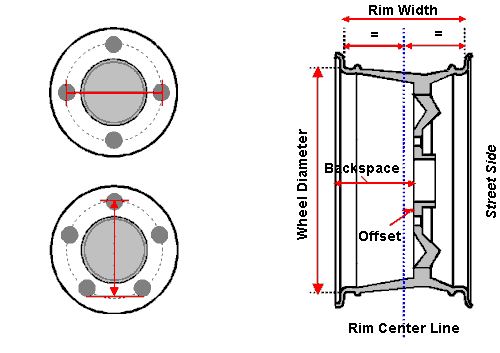คำตอบที่ 4
Wheel Essentials
There are several critical measurements to take into account when selecting a wheel or when replacing your stock wheels with aftermarket wheels (wheels and rims being used interchangeably in this article). Among these important measurements are:
Wheel Diameter
This is the total wheel diameter when measured from bead seat to bead seat. When replacing tires you of course must know the wheel diameter, but this will be stamped on the old tires. If you are browsing through a stack of wheels that are not stamped an easy way to determine the diameter is to measure the maximum diameter from rim to rim and then with a ruler measure the distance from the rim down to the bead seat. Subtract twice the distance which you measured down to the bead seat from the rim to rim diameter and you will have the correct wheel diameter. Wheel diameter is a critical consideration when changing or altering brake components. It is also believed by many that 15" wheels have a superior bead design and better bead retention than 16", 16.5" or 17" wheels.
Wheel Width
The wheel width or rim width is the distance between the outside edges of the bead seat. Most popular rim width for 4x4s would be 6", 7", 7.5", 8" and 10". Rims wider than this are usually only used on trucks with extreme overwidth tires. The tire manufacturer will publish guidelines for what rim width should be used with which tire. In general 7" rims will comfortably work with tires up to 10.5" wide, 8" wide rims work for 9.5" up to 12.5" wide tires and 10" wide rims are used for 12.5" and wider. Many rims will not be available in width wider than 8" and rims wider than 10" are much more difficult to find.
Rim width relative to tread width has an effect on bead retention when aired down and on the overall tire profile. In general a narrower wheel (from within the manufacturers guidelines) will result in a more rounded profile with a slightly smaller footprint but with slightly greater protection of the wheel. Narrower wheels also may retain the bead marginally better when aired down than will the wider wheels. Wider wheel provide a flatter tire profile and greater footprint. Since the rim is wider it will not be as protected from the rocks as would a narrower wheel with the same tire. The tire carcass will exert less pressure on the wider width bead when aired down and a wider wheel may thus be marginally more likely to lose a bead when pressures are low. Wider wheels, with less sidewall bulge, may reduce the rubbing of large tires on the springs at full turn.
Backspacing
Backspacing is the distance from the inside rim surface to the backside of the wheel mounting surface. It determines how far a wheel (& tire) sticks into or out of the wheel well of the vehicle. Wheels with a lot of backspacing will stick further in. Wheels with little back spacing will stick further out. Sometimes when swapping in wider axles 4x4 owners will switch to a wheel with much more backspacing to compensate. You should note that the backspacing measurement is critical when considering the wheels clearance of the suspension, braking and steering components as well as the body. All of these must be considered in both normal conditions and when at full suspension travel or articulation.
Offset
Offset is the distance from the exact wheel centerline to the inside wheel mounting surface. Offset and Backspacing are related. A large amount of offset can change the leverage and the loads on axle or wheel bearings and so if possible you should stay (within reason) close to the stock wheel offset. In addition to changing the load on the bearings changing the offset significantly will change the turning radius (of the tire) and may effect both steering response and steering stability.
Bolt Pattern
The bolt pattern has two essential parts. The first is simple it is the number of bolts. The second is the diameter of the "bolt circle". The bolt circle is an imaginary circle which passes through the centerline of each of the hubs wheel fasteners. On a wheel with 4, 6 or 8 bolt holes the measurement is simple: Just measure from the center of one hole to the center of the hole directly across from it. On a wheel with 5 bolt holes this is not possible. The next best thing, which will provide a "close enough" approximation is to measure from the center of one bolt hole to a line (or ruler) that is drawn between the opposite edge of the two opposing bolt holes. The bolt pattern is then indicated by the number of bolts X the bolt circle diameter - for example a 5x5.5" bolt pattern is 5 bolt hole arranged around a circle which is 5.5" in diameter. This may also be referred to as 5 on 5.5"






